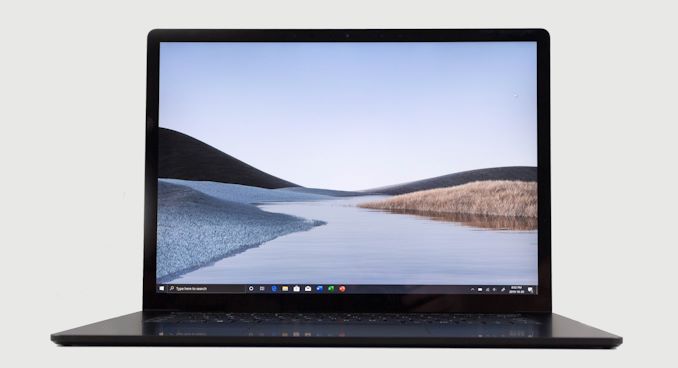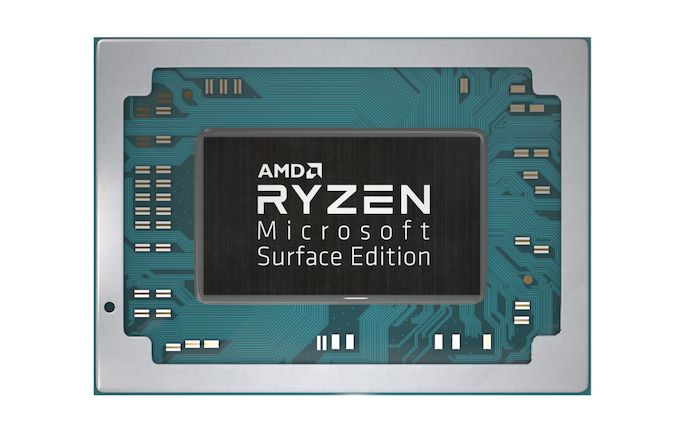The Microsoft Surface Laptop 3 Showdown: AMD's Ryzen Picasso vs. Intel's Ice Lake
by Brett Howse & Andrei Frumusanu on December 13, 2019 8:30 AM ESTFinal Words
Two laptops. Two platforms. It is rare to have a chance to see a manufacturer offer such equal footing to both AMD and Intel by outfitting a premium laptop with processors from both. It represents a rare opportunity to get to test the latest processors from AMD and Intel in a laptop in such an apples-to-apples fashion.
In the laptop space, design, cooling, and a manufacturers requirements can play a big part in how a particular chip performs, thanks to adjustable power level settings, surface temperature adjustments, and more. We have seen the lowest tier CPU outperform the highest tier CPU just by the virtue of a better cooling system, so to have processors from AMD and Intel, both of which launched in 2019, in the same chassis is a wonderful opportunity.
There aren’t too many ways to sugar coat the results of this showdown though. AMD’s Picasso platform, featuring its Zen+ cores and coupled with a Vega iGPU, has been a tremendous improvement for AMD. But Intel’s Ice Lake platform runs circles around it. Sunny Cove cores coupled with the larger Gen 11 graphics have proven to be too much to handle.
On the CPU side, no one should be too surprised by the results. We've already seen on the desktop that AMD’s Zen+ cores were competitive, but slightly slower than the previous Skylake platform; and the new Sunny Cove microarchitecture from Intel is a big step forward in terms of IPC for Intel. On purely CPU based tasks, Ice Lake really stretched its legs, and despite this being a 3.9 GHz chip, in single-threaded SPEC 2017, it managed to come very close to a 5.0 GHz Core i9-9900K with a massively higher TDP. Zen+ is outclassed here, and that showed in the benchmark results, and especially in the benchmark time. On our 8-thread SPEC 2017 run, the Ice Lake platform finished just a hair over two hours ahead of Picasso.
But things fare better for AMD on the GPU side of matters. Even though Intel has certainly closed the gap with Ice Lake's iGPU, AMD seems to continue to hold an advantage, especially on the 11 Compute Unit Ryzen Surface Edition processor found in the Surface Laptop 3. Intel has dedicated a lot more die area to the GPU and the results put them almost on equal footing with the Vega based GPU on Picasso. On the more complex GPU tasks, AMD tends to have a slight lead, and AMD’s low-level driver support also seems to benefit them on DirectX 12 based tasks. But, Ice Lake’s GPU is helped by the much quicker CPU it is coupled to, so depending on the specific test it can be even quicker.
Ice Lake does all of this with much better power efficiency as well. Overall battery life is quite a bit longer, and idle power draw is notably lower as well. Case in point: at minimum screen brightness, the Ice Lake system was pretty much only sipping power, drawing around 1.7 Watts, versus the 3.0 Watts for the AMD system.
It was fantastic to see AMD get a design win in a premium laptop this year, and the Surface Laptop 3 is going to turn a lot of heads over the next year. AMD has long needed a top-tier partner to really help its mobile efforts shine, and they now have that strong partner in Microsoft, with the two of them in a great place to make things even better for future designs. Overall AMD has made tremendous gains in their laptop chips with the Ryzen launch, but the company has been focusing more on the desktop and server space, especially with the Zen 2 launch earlier this year. For AMD, the move to Zen 2 in the laptop space can’t come soon enough, and will hopefully bring much closer power parity to Intel’s offerings as well.
Meanwhile for Intel, Ice Lake has been years in the making, and, after a long delay, it is finally here. After digging into the platform in-depth, it’s clear that Ice Lake is an incredibly strong offering from Intel. The CPU performance gains are significant, particularly because they were made in the face of a CPU frequency deficit. But the biggest gains were on the GPU side, where Intel’s Gen 11 GT2 in its full 64 Execution Unit configuration is likely the biggest single increase in GPU performance since they started integrating GPUs. It pulls very close to AMD’s Vega, closing the gap in performance to almost zero.
2019 has been a big year in the laptop space, with both Intel and AMD bringing new tools to the game. 2020 should be just as exciting, and if we’re lucky, we’ll get another chance to do this all over again.













174 Comments
View All Comments
yannigr2 - Saturday, December 14, 2019 - link
Nice. Let's run the single threaded SPEC2017 test to show how good Intel is against the new star, the Ryzen 9 3950.Let's run the multi threaded SPEC2017 test WITHOUT the desktop CPUs to avoid showing how bad Intel is against the Ryzen 9 3950.
yannigr2 - Saturday, December 14, 2019 - link
Thats way we can title both results as "Intel having an advantage"Where is the good old Anandtech?
Brett Howse - Saturday, December 14, 2019 - link
The comparison is 15W AMD to 15W Intel in the same laptop. Please refer to the title of the article.yannigr2 - Sunday, December 15, 2019 - link
Then why are there results from desktop processors ESPECIALLY on the SINGLE threaded performance, but no results on the multi threaded performance?Maybe to advertise the single threaded performance that Ice Lake offers, compared to Zen 2? Maybe because 16 Zen 2 cores obliterate Intel chips on multithreaded tests?
The fact that you avoid in the article to explain why you only post single threaded, but no multithreaded results from desktop processors explains much. Hides nothing.
One "Tom's Hardware" is enough. We don't need another.
Brett Howse - Sunday, December 15, 2019 - link
Because it's relevant on single-threaded but irrelevant on multi-threaded. If you're after desktop CPU reviews we have those as well. If we were going to run SPEC multi-thread on a desktop CPU we'd not be running it at Rate 8. Rate 8 was run on these two processors because they have 8 threads.Maxiking - Saturday, December 14, 2019 - link
Lol, amd trash brigading again.Haawser - Saturday, December 14, 2019 - link
I think 7nm Ryzen mobile will be a lot more competitive than Picasso. Which is 'ok' for a last generation 12nm effort, but unlikely to hold a candle to a 7nm Zen2 APU. So next year should be a really interesting one as far as notebooks are concerned.Cliff34 - Saturday, December 14, 2019 - link
Looking at the price, spec and performance, Intel is still the winner in the laptop areana. Why would anyone save 100 dollars for a laptop that is win home, slower and less battery life?eastcoast_pete - Saturday, December 14, 2019 - link
Two additional comments:1. The Ryzen version is overpriced; as is, it would still be an attractive option if the price would be $300 or so less. Right now, the value proposition is on the side of the Ice Lake i7 version.
2. Many comments here complain about how this comparison is unfair to AMD's APU. Why not complain about AMD not shipping a mobile APU based on Zen2 in 7 nm, preferably with Navi graphics on board, more L3 cache, and LPDDR4 support? Isn't that the likely reason for Ice Lake taking the cake here, and trouncing AMD?
As is, I view the current Ryzen mobile APUs as good choices for mid-level machines suitable for occasional e-sports gaming, not for running a premium ultraportable $ 2000+ laptop.
MBarton - Monday, December 30, 2019 - link
"2. Many comments here complain about how this comparison is unfair to AMD's APU. Why not complain about AMD not shipping a mobile APU based on Zen2 in 7 nm, preferably with Navi graphics on board, more L3 cache, and LPDDR4 support? Isn't that the likely reason for Ice Lake taking the cake here, and trouncing AMD?"Because all Zen 2 production is being channeled into HIGH profit server and HEDT CPU sales. While Intel fans get a moral victory in the Surface 3 review, their 10nm CPU parts are making Intel very little money using a process node they have burned billions trying to get working. AMD doesn't have the convenience of diverting valuable 7nm parts to low margin mobile sales. Congrats to Intel, they've won a much needed but very hollow victory.